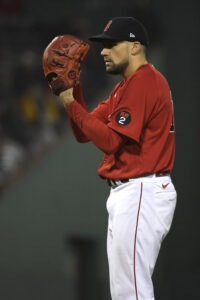The Rangers announced another rotation addition, signing Nathan Eovaldi to a two-year deal with a vesting/player option for the 2025 campaign. The ACES client will be paid a $2MM signing bonus followed by $16MM salaries in each of the next two seasons. The option — which is valued at $20MM — would kick in as a player option if Eovaldi throws 300 combined innings from 2023-24. It’d also be triggered if the righty finishes in the top five in Cy Young voting in 2024 or finishes in the top seven that year and qualifies for the All-Star team. Eovaldi also has limited no-trade protection and innings-based incentives that could allow him to make as much as $63MM over the next three seasons.
Eovaldi has spent the past four-plus seasons with the Red Sox. Boston first acquired the righty from the Rays at the 2018 trade deadline, adding the impending free agent for their playoff push. Eovaldi was excellent in 12 regular season appearances, then added 22 1/3 innings of 1.61 ERA ball in the postseason. At year’s end, Boston rewarded him for his finish with a four-year, $68MM free agent deal.
That contract looked shaky in year one, as Eovaldi posted an ERA just south of 6.00 in 2019 — a season in which he missed a notable chunk of action due to loose bodies in his throwing elbow. He righted the ship in the second season, though, posting a 3.72 ERA through nine outings during the shortened 2020 campaign.
Eovaldi followed up with maybe the best full season of his career in 2021. He made all 32 starts and posted a 3.75 ERA through 182 1/3 innings, striking out 25.5% of opponents against a 4.6% walk rate. That showing earned him his first career All-Star selection, as well as a fourth place finish in AL Cy Young balloting.
Unfortunately, injury issues cropped back up in 2022. Eovaldi missed chunks of what proved to be his final season in Boston due to a pair of injured list stints. He lost time between June and July with lower back inflammation and missed most of August and September thanks to inflammation in his throwing shoulder. The pair of injuries kept him to 20 starts and 109 1/3 frames, although his production on a rate basis was around his career norms.
Eovaldi managed a 3.87 ERA, striking out a slightly above-average 22.4% of batters faced. He walked a minuscule 4.3% of opponents while inducing grounders on 47% of batted balls he surrendered. Eovaldi isn’t the ace his 2021 fourth-place Cy Young finish might suggest, but he’s an above-average mid-rotation arm when healthy.
That production doesn’t come the way one might expect given Eovaldi’s power arsenal. He’s one of the game’s hardest throwers, averaging north of 97 MPH for much of his career. However, he’s never posted the elite strikeout rates typically associated with that velocity. Eovaldi’s best trait is instead his ability to pound the strike zone. He’s walked fewer than 5% of opponents in each of the past three years; his cumulative 4.4% walk percentage since the start of 2020 is second-lowest among the 120 pitchers with 200+ frames over that stretch (trailing only the 4.3% mark of Clayton Kershaw).
Eovaldi’s willingness to attack the zone has led to home run issues at times. He’s allowed homers at a higher than average clip in three of the last four years, including an elevated 1.73 homers per nine innings this past season. That’s the only red flag in Eovaldi’s recent performance track record but his health and age presumably gave some teams pause. He’ll be 33 in February, making him one of the older options in a deep class of mid-rotation starters available in free agency.
In addition to this year’s shoulder and back concerns, he has a history of elbow problems. Eovaldi underwent Tommy John surgery in high school, then missed the 2017 campaign after undergoing the procedure a second time in August 2016. He hasn’t required any IL stints due to elbow concerns since the aforementioned 2019 loose bodies. The back and shoulder injuries of this past season might be more acute problems, as Eovaldi’s average fastball velocity dipped from its customary 96-97 MPH range early in the season to roughly 94 MPH after his first IL stint.
Those injuries seemed to depress Eovaldi’s market. Chris Bassitt landed a three-year, $63MM deal headed into his age-34 campaign, while players like Jameson Taillon and Taijuan Walker secured strong four-year pacts despite less consistent performance track records than Eovaldi’s. Many of the free agent starters this offseason landed stronger than expected deals, but Eovaldi’s guarantee exactly matches MLBTR’s prediction from the outset of the offseason.
Eovaldi’s camp was also working against the qualifying offer. He turned down a QO from Boston at the start of the winter, tying any signing team to draft compensation. That was also the case for Bassitt but didn’t come into play for Walker and Taillon.
Texas hasn’t shown much concern about losing draft choices to add quality talent via free agency. They surrendered two picks to sign Corey Seager and Marcus Semien last winter, and they’ll do so again this offseason. The Rangers already forfeited a draft choice to sign Jacob deGrom to a five-year deal. That lessens the price they’ll have to pay in Eovaldi’s case. Texas surrendered their second-highest draft choice in 2023 and $500K in international signing bonus space to add deGrom. They’ll be docked another $500K in signing bonus room and their third-highest pick for Eovaldi.
After the Seager and Semien splashes to bolster the lineup last offseason, the Rangers have thoroughly overhauled their starting staff this winter. Texas acquired Jake Odorizzi from the Braves within the first few days. Left-hander Martín Pérez soon after accepted a qualifying offer, but that didn’t slow down Texas GM Chris Young or his front office. Since free agency opened, they’ve nabbed deGrom on the largest pitching contract of the offseason and brought in Andrew Heaney and Eovaldi on two-year guarantees.
Eovaldi adds another mid-rotation caliber starter to what now looks like a potentially fearsome Rangers rotation. deGrom headlines the staff, backed up by Jon Gray, Eovaldi, Pérez and Heaney. Odorizzi and Dane Dunning seem as if they’ll be pushed into depth roles, though there’s enough injury uncertainty with most of the top five it’s understandable Texas wouldn’t take its foot off the gas in pursuing outside help.
Owner Ray Davis and the front office haven’t shown many qualms about spending. Tacking on Eovaldi’s $16MM salary to next year’s books brings their projected payroll around $196MM, per Roster Resource. That’ll be a franchise record, easily topping the organization’s previous Opening Day high-water mark of $165MM. The deal’s $17MM average annual value brings their competitive balance tax number around $220MM, per Roster Resource, leaving them $13MM shy of next year’s $233MM base tax threshold.
The rotation hefty lifting looks to be complete, but Texas is known to be seeking ways to upgrade in the corner outfield. There’s room for a mid-tier free agent pickup there if the team prefers to stay under the CBT marker, though it’s also possible Davis is comfortable pushing past that threshold. The franchise’s boldness this winter has backed up their claims they plan to compete for a playoff spot in 2023, as both the Rangers and Angels have worked to try to close the gap with the Astros and Mariners in the AL West.
It’s another free agent departure for the Red Sox, who have seen a few notable players head elsewhere. Eovaldi and Xander Bogaerts each left after declining a qualifying offer. Boston receives draft compensation for both, though that’s a rather minimal benefit in their case. The Red Sox narrowly exceeded the CBT threshold in 2022, a decision that didn’t pay off when the club stumbled to a last-place finish down the stretch. They only receive bonus selections after the fourth round in next year’s draft as a result.
Robert Murray of FanSided first reported the Rangers and Eovaldi were in agreement. Evan Grant of the Dallas Morning News was first to report it was a two-year deal with an option, as well as the specific financial breakdown. Jeff Passan of ESPN was first with the $34MM guarantee and the third-year option being a vesting/player provision, as well as the option specifics. Jon Heyman of the New York Post first reported the no-trade protection and potential to vest the option based on Cy Young voting.
Image courtesy of USA Today Sports.

